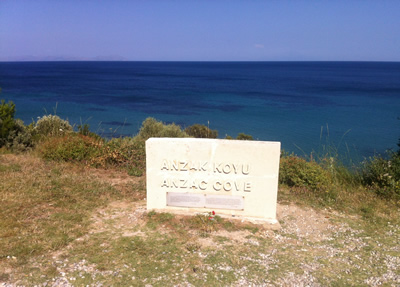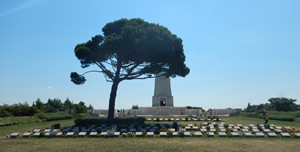Geography Stage 2
Overview

Anzac Cove, Gallipoli, 2014
©Department of Education (Wiley Park GHS)
Students undertake a cultural study of Istanbul and Sydney and identify similarities and differences in the natural and human features of each country, climate, settlement patterns, demographics and daily life of people. They investigate people’s perceptions of the Anzac memorials on the Gallipoli peninsula and construct links between perceptions and protection of places.
Teaching and learning activities

Lone Pine Cemetery, Gallipoli, 2014
©Department of Education (Wiley Park GHS)
Question: How and why is Istanbul and Sydney similar and different? How do people’s perceptions of memorials on the Gallipoli peninsula influence actions that protect it?
Cultural study: Istanbul, Turkey and Sydney, Australia
Researching
Locate Turkey and Australia on a world map and globe.
Locate and research the most populated city of each: Istanbul and Sydney.
Research the natural and human features of each country.
Research the climate, settlement patterns, demographics and daily life of people in Istanbul and Sydney.
View a map of Gallipoli in Turkey and Anzac Cove and a gallery of images from the Anzac peninsula
View the videos of students reflecting on their visit to the Anzac Cove memorial in Turkey (from the Including all students tab).
Discuss why the site is important to Australians and why they visit it.
Processing
Create an annotated photo collage of images of Istanbul and Sydney.
Create a comparison table of key information for Istanbul and Sydney and use that to generated a Venn Diagram of similarities and differences.
Using one of the concepts—Challenge, Change, Caring, Community or Commemoration—students create a chart or mind-map summarising the key points from one of student videos visually or as dot points. Share with other students.
Discuss the relationship between Turkish people and Australian people in regard to the Anzacs. Make connections between perceptions and protection of the Anzac memorials.
Communicating
Students write a thank you letter to the people of Turkey for caring for the memorials to the Anzacs on the Gallipoli peninsula. In the letter students demonstrated their knowledge of Turkey and demonstrate intercultural understanding
Learning concepts
These additional questions can be used for discussion or further investigations.
Challenge
What challenges did the landforms of Anzac Cove and the Gallipoli Peninsula present to the Anzacs?
Change
What changes have occurred to the landscape of the trenches since the First World War? What evidence of the trenches still remains?
Caring
How do the Turkish people show that they care about the Anzac memorials on the Gallipoli peninsula?
Community
How is a sense of community created at the Anzac memorials on the Gallipoli peninsula?
Commemoration
How are Anzacs and Turks commemorated on the Gallipoli peninsula?
Syllabus links
GE2-1 examines features and characteristics of places and environments
GE2-2 describes the ways people, places and environments interact
GE2-3 examines differing perceptions about the management of places and environments
GE2-4 acquires and communicates geographical information using geographical tools for inquiry
Australia’s neighbours
Students:
-
investigate Australia’s neighbouring countries and their diverse characteristics, for example: (ACHGK016)
– location of Australia’s neighbouring countries
– examination of the natural and human features of neighbouring countries
– comparison of the natural and human features of a city in Australia with a city in a neighbouring country
Climate of places
Students:
-
investigate the climates of different places, for example: (ACHGK017)
– comparison of climates in different places
Similarities and differences between places
Students:
-
investigate the settlement patterns and demographic characteristics of places and the lives of the people who live there, for example: (ACHGK019)
– examination of the varying settlement patterns and demographics of places
– comparison of the daily life of people from different places
Perception and protection of places
Students:
-
investigate how the protection of places is influenced by people’s perception of places, for example: (ACHGK018)
– description of how and why people perceive places differently
– discussion of how people’s perceptions influence the protection of places